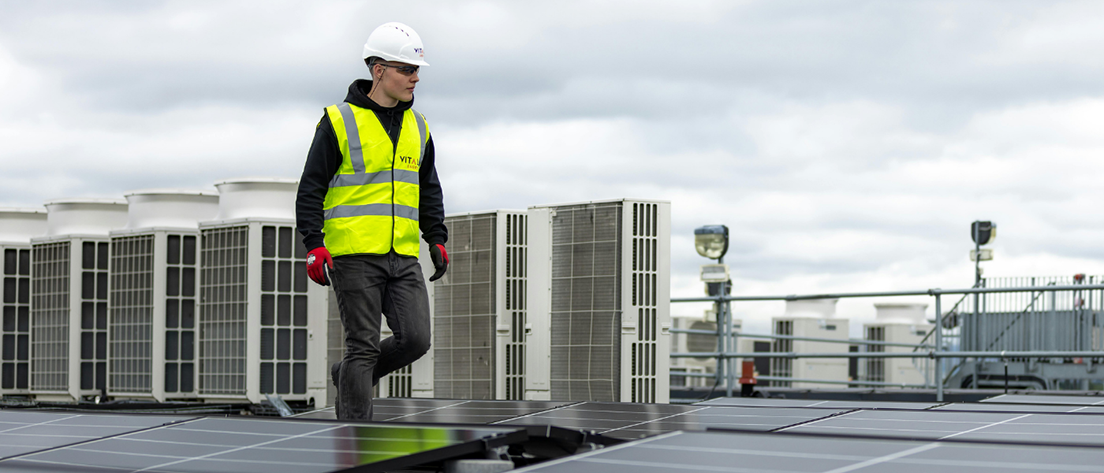
5 Common Issues Found During Commercial Roof Inspections
Commercial roofs in the Midwest take a beating. Whether it’s the sun beating down in the summer or the heavy snow weighing on it in the winter, these environmental challenges often lead to problems.
With Chicago’s unpredictable weather, a single missed inspection could mean the difference between smooth operations and a complete shutdown of your building.
Ridgeworth Roofing has worked with commercial building owners for over 50 years, doing installations, regular maintenance, and inspections.
With all of our experience out in the field, here are the 5 most common issues found during commercial roof inspections.
1. Leaks

A small leak today, a structural collapse tomorrow.
Leaks are the most common and dangerous issues we find during inspections. Damaged or improperly installed flashing, punctures, clogged drainage systems, or cracks all lead to leaky roofs.
Because the Midwest deals with heavy rains and snow storms regularly, an unchecked roof leak escalates to a serious problem quickly.
For example, a roof leak sometimes damages commercial building’s interiors, resulting in mold, weakened structural integrity, and damaged insulation. We frequently find water dripping during inspections are a result of Chicagoland’s rain storms.
Don’t wait for the next storm to turn a small drip into a full-blown disaster. Call a professional roofing company immediately if you spot even the slightest sign of water damage.
2. Ponding Water

Ponding water is more than just a nuisance—it’s a ticking time bomb for your roof.
After heavy rain or snow melts, water that stays on your roof for more than 48 hours weakens the membrane and can lead to structural failure. In extreme cases, ponding water has caused entire roofs to collapse, putting people and property in danger.
The longer water weighs heavily on your commercial roof, the faster the membrane deteriorates causing leaks and structural damage.
To avoid ponding water, you need to improve the drainage system by either installing more drains, or using tapered insulation that directs the water toward the drains.
If your roof doesn’t drain properly, it’s only a matter of time before costly damages occur. You’ll want to Improve your drainage system quickly to prevent leaks, deterioration, or worse.
3. Damaged Flashing

Extreme weather conditions can be a challenge in the Chicagoland area commercial roofs.
Flashing is the barrier that prevents water from seeping into your building at its most vulnerable points—edges, skylights, vents, and chimneys. In Chicago’s volatile weather, damaged or worn flashing can quickly lead to widespread leaks and roof failure.
In Chicago, fluctuating temperatures, heavy snow, and intense winds accelerate flashing deterioration. During winter, snow and ice strains flashing, causing it to crack or become loose.
Damaged flashing might seem like a small issue, but in freezing and thawing cycles, it expands, cracks, and lets in water, causing structural rot.
4. Cracked Membranes

The membrane of your roof acts as a waterproof shield.
However, Chicago’s harsh weather—from freezing winters to sweltering summers—causes expansion and contraction, leading to cracks that allow water to infiltrate your building. These cracks often go unnoticed until it’s too late, causing internal water damage that leads to expensive repairs.
When left unattended, water seeps into the building. But it isn’t just the winter you need to worry about. Hot summer temperatures cause some roofing materials to dry out, become brittle, and lose their flexibility, making them more prone to cracking.
We often see cracked membranes on days following extreme temperature fluctuations or weather events. A prompt response protects your commercial roof and building from structural damage.
5. Poor Repairs

Quick fixes sometimes lead to long-term problems. With commercial roofs in particular, if you don’t fix the underlying problem, you’re going to have trouble.
Temporary repairs performed by inexperienced contractors or building maintenance crews looking to save time and money can worsen the damage. The problem might be sight unseen for the time being, but when we go and check everything out, there sometimes is something more destructive lying in wait.
Because of the Chicago area’s weather fluctuations, temporary fixes don’t hold up long term. Some materials might not stand strong winds, or freeze-thaw cycles leading to water infiltration or building structure disintegration.
A quick fix might seem appealing, but it will cost you in the long run. Before any temporary repairs fail, contact a roofing professional to ensure your roof is secure and protected.
Having Commercial Roof Trouble? Call Ridgeworth Roofing Today.
Ridgeworth Roofing has over 50 years of experience keeping Chicagoland roofs in top condition. Schedule your next commercial roof inspection with us today, and let our team catch potential issues before they become expensive emergencies.
